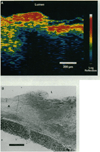Optical coherence tomography
- PMID: 1957169
- PMCID: PMC4638169
- DOI: 10.1126/science.1957169
Optical coherence tomography
Abstract
A technique called optical coherence tomography (OCT) has been developed for noninvasive cross-sectional imaging in biological systems. OCT uses low-coherence interferometry to produce a two-dimensional image of optical scattering from internal tissue microstructures in a way that is analogous to ultrasonic pulse-echo imaging. OCT has longitudinal and lateral spatial resolutions of a few micrometers and can detect reflected signals as small as approximately 10(-10) of the incident optical power. Tomographic imaging is demonstrated in vitro in the peripapillary area of the retina and in the coronary artery, two clinically relevant examples that are representative of transparent and turbid media, respectively.
Figures



Similar articles
-
Macular disease and optical coherence tomography.Curr Opin Ophthalmol. 1996 Jun;7(3):33-8. doi: 10.1097/00055735-199606000-00006. Curr Opin Ophthalmol. 1996. PMID: 10163457 Review.
-
Imaging of macular diseases with optical coherence tomography.Ophthalmology. 1995 Feb;102(2):217-29. doi: 10.1016/s0161-6420(95)31032-9. Ophthalmology. 1995. PMID: 7862410
-
Optical coherence tomography to detect and manage retinal disease and glaucoma.Am J Ophthalmol. 2004 Jan;137(1):156-69. doi: 10.1016/s0002-9394(03)00792-x. Am J Ophthalmol. 2004. PMID: 14700659 Review.
-
Optical coherence tomography of central serous chorioretinopathy.Am J Ophthalmol. 1995 Jul;120(1):65-74. doi: 10.1016/s0002-9394(14)73760-2. Am J Ophthalmol. 1995. PMID: 7611331
-
Optical coherence tomography.Semin Ophthalmol. 1998 Dec;13(4):199-202. doi: 10.3109/08820539809056053. Semin Ophthalmol. 1998. PMID: 9878670 Review.
Cited by
-
Assessment of frame-averaging algorithms in OCT image analysis.Ophthalmic Surg Lasers Imaging Retina. 2013 Mar-Apr;44(2):168-75. doi: 10.3928/23258160-20130313-09. Ophthalmic Surg Lasers Imaging Retina. 2013. PMID: 23510042 Free PMC article.
-
Robust Identification and Segmentation of the Outer Skin Layers in Volumetric Fingerprint Data.Sensors (Basel). 2022 Oct 27;22(21):8229. doi: 10.3390/s22218229. Sensors (Basel). 2022. PMID: 36365934 Free PMC article.
-
Noise and bias in optical coherence tomography intensity signal decorrelation.OSA Contin. 2020 Apr 15;3(4):709-741. doi: 10.1364/OSAC.385431. Epub 2020 Mar 17. OSA Contin. 2020. PMID: 34085035 Free PMC article.
-
Phase-sensitive OCT imaging of multiple nanoparticle species using spectrally multiplexed single pulse photothermal excitation.Biomed Opt Express. 2012 Oct 1;3(10):2579-86. doi: 10.1364/BOE.3.002579. Epub 2012 Sep 17. Biomed Opt Express. 2012. PMID: 23082297 Free PMC article.
-
Review of spectral domain-enhanced depth imaging optical coherence tomography of tumors of the retina and retinal pigment epithelium in children and adults.Indian J Ophthalmol. 2015 Feb;63(2):128-32. doi: 10.4103/0301-4738.154384. Indian J Ophthalmol. 2015. PMID: 25827543 Free PMC article. Review.
References
Publication types
MeSH terms
Grants and funding
LinkOut - more resources
Full Text Sources
Other Literature Sources

